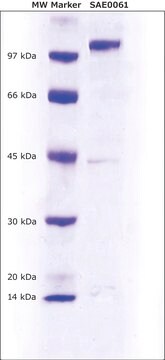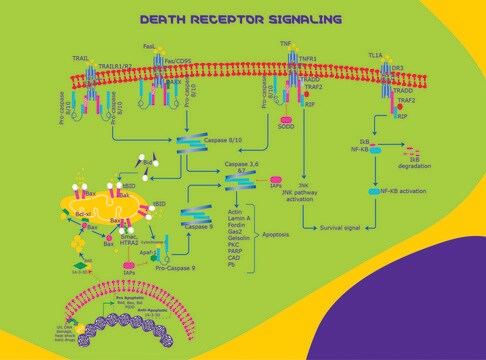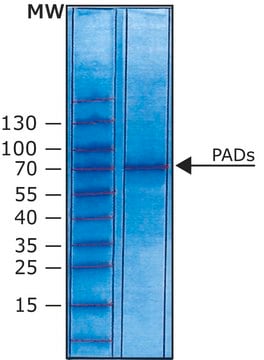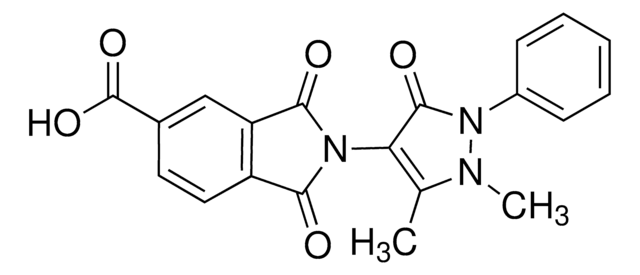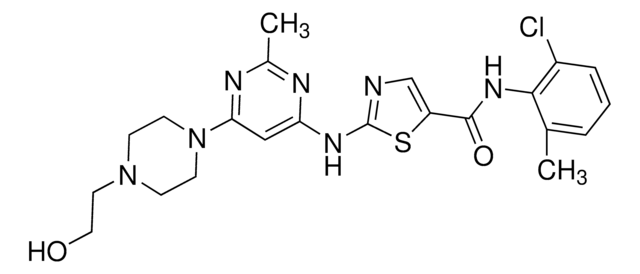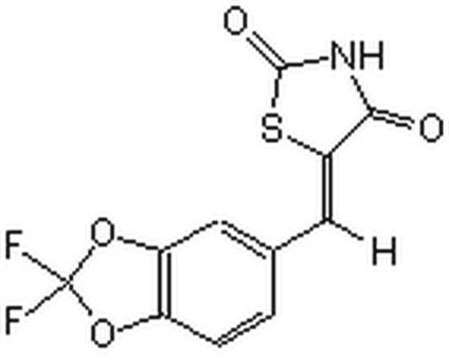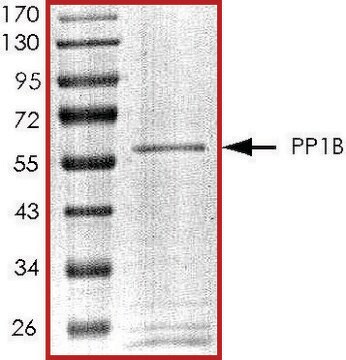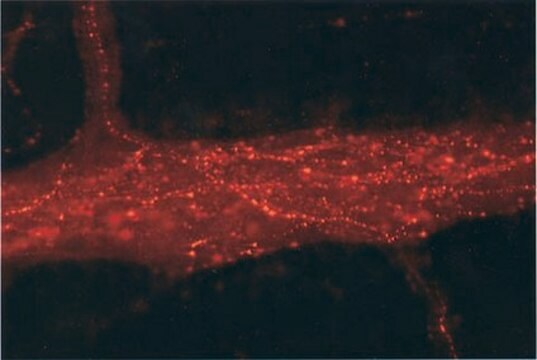SRP5223
PAD1, GST tagged human
recombinant, expressed in baculovirus infected Sf9 cells, ≥70% (SDS-PAGE), buffered aqueous glycerol solution
Sinônimo(s):
HPAD10, PADI1, PDI, PDI1
Faça loginpara ver os preços organizacionais e de contrato
About This Item
Código UNSPSC:
12352200
NACRES:
NA.32
Produtos recomendados
fonte biológica
human
recombinante
expressed in baculovirus infected Sf9 cells
Ensaio
≥70% (SDS-PAGE)
Formulário
buffered aqueous glycerol solution
peso molecular
~95 kDa
nº de adesão NCBI
aplicação(ões)
cell analysis
Condições de expedição
dry ice
temperatura de armazenamento
−70°C
Informações sobre genes
human ... PADI1(29943)
Descrição geral
Peptidyl arginine deiminase 1 (PAD1) is a member of the peptidyl arginine deiminase family of enzymes. It is a component of the 26S proteasome, a multiprotein complex that degrades proteins targeted for destruction by the ubiquitin pathway. PAD1 is expressed in the epidermis and uterus. The gene encoding this protein is localized on human chromosome 1p36.13.
Ações bioquímicas/fisiológicas
Peptidyl arginine deiminases catalyze the post-translational deimination of proteins by converting arginine residues into citrullines in the presence of calcium ions. The overexpression of PAD1 induced a distinctive pattern of multidrug resistance in mammalian cells and moderate resistance to ultraviolet light. PAD1 is also responsible for substrate deubiquitination during proteasomal degradation. It deiminates filaggrin in the last stages of keratinocyte differentiation. Thus, PAD1 has a role in epidermis function and homeostasis. The protein has been genetically associated with rheumatoid arthritis.
forma física
Supplied in 50mM Tris-HCl, pH 7.5, 150mM NaCl, 10mM glutathione, 0.1mM EDTA, 0.25mM DTT, 0.1mM PMSF, 25% glycerol.
Nota de preparo
after opening, aliquot into smaller quantities and store at -70 °C. Avoid repeating handling and multiple freeze/thaw cycles
Nota de análise
This protein is not assayed for enzymatic activity.
Código de classe de armazenamento
10 - Combustible liquids
Classe de risco de água (WGK)
WGK 1
Ponto de fulgor (°F)
Not applicable
Ponto de fulgor (°C)
Not applicable
Escolha uma das versões mais recentes:
Certificados de análise (COA)
Lot/Batch Number
Não está vendo a versão correta?
Se precisar de uma versão específica, você pode procurar um certificado específico pelo número do lote ou da remessa.
Já possui este produto?
Encontre a documentação dos produtos que você adquiriu recentemente na biblioteca de documentos.
Citrullination of CXCL8 by peptidylarginine deiminase alters receptor usage, prevents proteolysis, and dampens tissue inflammation.
Proost P
The Journal of Experimental Medicine (2008)
Potential Role of Peptidylarginine Deiminase Enzymes and Protein Citrullination in Cancer Pathogenesis
Sunish Mohanan, et.la
Biochemistry Research International (2012)
The peptidylarginine deiminases expressed in human epidermis differ in their substrate specificities and subcellular locations.
Mechin MC
Cellular and Molecular Life Sciences (2005)
Identification of 45 novel SNPs in the 83-kb region containing peptidylarginine deiminase types 1 and 3 loci on chromosomal band 1p36.13.
Lida A and Nakamura Y
Journal of Human Genetics (2004)
Tingting Yao et al.
Nature, 419(6905), 403-407 (2002-09-28)
The 26S proteasome is responsible for most intracellular proteolysis in eukaryotes. Efficient substrate recognition relies on conjugation of substrates with multiple ubiquitin molecules and recognition of the polyubiquitin moiety by the 19S regulatory complex--a multisubunit assembly that is bound to
Nossa equipe de cientistas tem experiência em todas as áreas de pesquisa, incluindo Life Sciences, ciência de materiais, síntese química, cromatografia, química analítica e muitas outras.
Entre em contato com a assistência técnica
